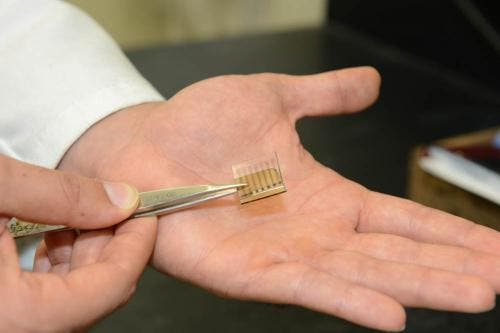Scientists at Stanford University have successfully devised the world’s first solar cell made entirely out of carbon. This alternative to typical silicon solar panels is not only a lot cheaper to produce, but also a lot less simpler to use. Such carbon cells can be coated on any surface and turn it into a solar panel, be it windows, roof tops and so on.
“Carbon has the potential to deliver high performance at a low cost,” said study senior author Zhenan Bao, a professor of chemical engineering at Stanford. “To the best of our knowledge, this is the first demonstration of a working solar cell that has all of the components made of carbon. This study builds on previous work done in our lab.”

This shows the new all-carbon solar cell consists of a photoactive layer, which absorbs sunlight, sandwiched between two electrodes. Credit: Mark Shwartz / Stanford University
A solar cell is made out of a photoactive layer, sandwiched between two electrodes. As light hits the the photoactive layer, photons are sucked in and turned into electrons. Typically, the electrode bottom and top layers are made out of indium tin oxide (ITO), a very rare and expensive material. The Stanford scientists chose to take an alternate, more sustainable path by using carbon, a low-cost and Earth-abundant material.
Bao and colleagues replaced the ITO used in conventional electrodes with graphene – sheets of carbon that are one atom thick –and single-walled carbon nanotubes that are 10,000 times narrower than a human hair. “Carbon nanotubes have extraordinary electrical conductivity and light-absorption properties,” Bao said.
As for the photoactive layer, the researchers used a new material comprised of buckyballs and carbon nanotubes. The carbon films can be made from thin solution can be coated on any surface, which makes it a highly versatile solution. I know this sounds too good to be true, truth is it still is. It’s main drawback is in its efficiency – only 1% which is really, really low by any standards. This is because the carbon film primarily absorbs near-infrared wavelengths of light.
“We clearly have a long way to go on efficiency,” Bao said. But with better materials and better processing techniques, we expect that the efficiency will go up quite dramatically.
The researchers are now experimenting with carbon nanomaterials that can absorb a broader spectrum of light, including the visible spectrum. This should kick up the efficiency a notch or two. Despite this, however, as they are currently they could still become viable, since they can make up in volume, where they lack in efficiency.
“Photovoltaics will definitely be a very important source of power that we will tap into in the future,” Bao said. “We have a lot of available sunlight. We’ve got to figure out some way to use this natural resource that is given to us.”
Findings were published in the journal ACS Nano.









